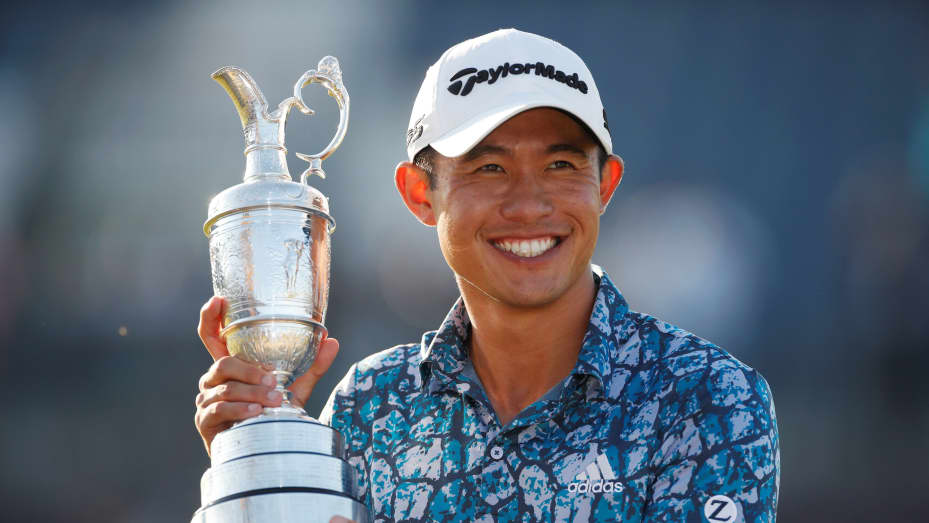 There was a moment yesterday, during the presentation of the Claret Jug to Collin Morikawa, when I thought his overwhelmingly positive reception by the patrons at Royal St. George might turn to enmity. As reported by Yahoo Sports, there was an “audible gasp” and “stir on social media” when the new champion said, “To see some of the best crowds I’ve ever seen, I look forward to my trip every year to the British (my emphasis) Open to see you guys.” The United States does not have a monopoly on political correctness.
There was a moment yesterday, during the presentation of the Claret Jug to Collin Morikawa, when I thought his overwhelmingly positive reception by the patrons at Royal St. George might turn to enmity. As reported by Yahoo Sports, there was an “audible gasp” and “stir on social media” when the new champion said, “To see some of the best crowds I’ve ever seen, I look forward to my trip every year to the British (my emphasis) Open to see you guys.” The United States does not have a monopoly on political correctness.
Some think referring to the final major each year as THE OPEN is a relatively new phenomenon. Actually, the opposite is true. Just ask Malcolm Booth, the communications director for the Royal and Ancient Golf Club of St. Andrews, golf’s most recognizable venue and the present day keeper of the flame.
The name of the championship hasn’t changed in 155 years. The reason we think 155 years on there (sic) is legitimacy in calling it ‘The Open Championship’ is it really was the birthplace of open competition. (Associated Press interview in 2016)
Hard to argue with that, except times have changed. A century and a half ago, the event at St. Andrews was the only “open” golf competition which allowed both professionals and amateurs (as opposed to the “open era” in tennis which began in 1968). Today, every country which now belongs to the community of golfing nations has a similar if not quite as venerable event. The same might be said if one compares the world of George Washington with the present. When the United States emerged as the first modern republic in 1789, if you referred to Washington as THE president, everyone knew about whom you were talking. But imagine if, today, the secretary general of the United Nations introduced Joe Biden as THE president. He would be greeted with more catcalls than Roger Goodell at a Patriots football game.
However, this was just one of many stories coming out of Sandwich, Kent, England. The return of the open and its patrons. Phil Michelson’s first round 80. Jordan Spieth’s roller coaster ride to a second place finish. Another Oosthuizen near miss. However, the main event was the contrast between two American players which mirrored what may be the major but least documented factor causing the current division in the American psyche. Not partisanship or ideology or even culture. STYLE!
At one extreme of the spectrum was Bryson DeChambeau. In 2019, DeChambeau promised to transform himself and the game of golf by gaining 30 pounds and focusing on swing speed. His goal? To overpower a golf course starting from the tee box with drives that left him with short irons to almost every green. Since re-emerging as the “bully of the fairways” in 2020, he has won three tournaments including the 2020 U.S. Open. [NOTE: Prior to the transformation he won five PGA tournaments from June 2017 through November 2018.]
He has two other traits which might also remind you of another American. He believes he always has the right answer, and when he does not succeed, he looks for a scapegoat. This latter characteristic was on full display last week when he blamed Cobra, the manufacturer of his driver, for all the errant tee shots that left him three over par, 15 strokes off the lead, at the finish of Saturday’s third round.
At the other extreme was the eventual winner Morikawa. Above all, he paid attention to history. He took a lesson from Tiger Wood’s 2006 Open victory at Hoylake, when he pulled out his driver only once over four days. Prioritizing ball placement over distance, Woods avoided the overgrown rough and pot bunkers that spelled disaster for other competitors. A similar approach served Morikawa well as he finished the tournament without a bogey on any of the final 31 holes.
This diversity in styles, a modern day fable of a hare (DeChambeau) and a tortoise (Morikawa), is why, despite the location, this Open was much more American than British. It was a metaphor for the state of our nation’s body politic which is too often driven (pun intended) by decibel level rather than substance. Where a belief there is nothing to learn from history competes with knowledge and experience.
There is an old saying among golfers. “You drive for show and putt for dough.” DeChambeau, like that other American, does put on a good show. But the proof is in the putting. Can you effectively finish what you started? If golfers were assessed like Olympic divers and skaters, it’s safe to say the panel of judges (and history) would still be out. Otherwise, you have to look at the scorecard where the record currently sits at the 24 year-old, 160 pound tortoise-two majors, the 27 year-old, 240 pound hare-one. For now at least, Aesop is still right!
For what it’s worth.
Dr. ESP
To early readers of today’s blog, I apologize for the picture of Morikawa and the Wannamaker Trophy which he won at the 2019 PGA Championship. It has since been replaced with the correct image of Morikawa holding the Claret Jug.
Well put Dr. ESP!